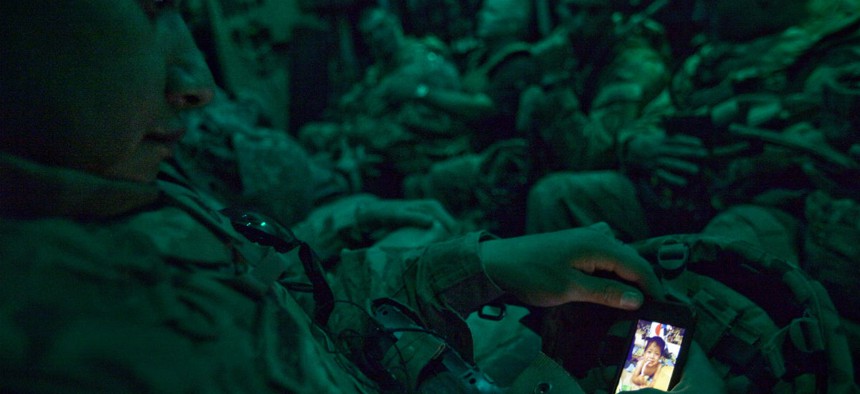DARPA Wants to MacGyver the Internet Using Only What's in Troops' Pockets

Staff Sgt. Rulberto Qjendismiranda, 20, of Seaside, Calif, with the U.S. Army's 2nd Battalion 27th Infantry Regiment based in Hawaii, looks at a photo of his son Marziano, 11 months, on his mobile phone aboard a military transport flight. David Goldman/AP File Photo
The research agency wants to tap the computer power of the devices warfighters already have to network anywhere.
Modern technology is helping soldiers push to the limits of their physical capabilities on the battlefield, but advancements in communication and assimilation of data still rely on a 1990s-era legacy premise: a networked connection to a military data center.
Today’s battlefields require significant information processing capabilities, such as the sending of images, videos and sensor data, yet extensive data processing and exchange relies on dependable network connections and bandwidth capabilities that don’t always exist.
This is a problem the Defense Advanced Research Projects Agency—the Defense Department’s research arm—has grappled with for years, but recent contract awards through its dispersed computing (DCOMP) program may be the first steps the U.S. military takes toward mitigating this problem.
» Get the best federal technology news and ideas delivered right to your inbox. Sign up here.
Specifically, according to program manager Steve Jameson, DARPA “seeks to design systems able to operate in environments where network connectivity is highly variable and degraded. The envisioned computing paradigm aims to enable the strategic, opportunistic movement of code to data, and data to code, in a fashion that best suits user, application, and mission needs.”
Kevin Kelly, chief executive officer of LGS Innovations, offered Nextgov an outline of this theoretical technology might look like in action. LGS Innovations was recently awarded a four-year, $7.5 million contract by DARPA as part of the DCOMP program’s first phase. Three other companies, Raytheon BBN, BAE and Vencore Labs, were awarded similar contracts addressing other aspects of the program.
“What if on the battlefield we use the information, memory and computing power available on everybody’s devices in a localized environment and in a localized manner? That’s what dispersed computing is all about,” Kelly said.
The example can be applied to the average retail consumer, who may have a laptop, smartphone, tablet or even web-connected vehicle. Those devices can share information among them, but they do so through centralized internet connections. If a user wants to transfer a photo from one device to another, he or she moves them through a cloud-based photo library.
A dispersed computing environment, Kelly said, would allow the seamless exchange of data, memory or computing horsepower among those devices without the need for a centralized connection.
“Why can’t my laptop get pictures off my phone without going through the internet? The reality is that it can, but it is not programmed to do that. The user authentication, validation of data—all that happens in the cloud,” Kelly said. He said dispersed computing “pushes functionality as close to the edge as possible” away from a centralized environment.
Modern warfighters, like their consumer counterparts, have radios, locators, smartphones, sensors and other devices with computing and storage capabilities that, with the proper architecture and algorithms, could pool those resources together. The higher the number of warfighters and networked computing devices, the stronger the dispersed computing system’s capabilities.
“What if instead of going to the cloud, the cloud was all around you?” Kelly said.
If it sounds simple in theory, Kelly said it will be far more complex to put into practice.
The first big hurdle will be the “networking challenge,” he said. Concepts like latency, the practicalities of electron flow and other physics dilemmas boil down to complex mathematical issues.
“Right now, it’s a big math problem,” Kelly said.
Should that problem prove solvable, the next stage of dispersed computing’s evolution will be establishing architectures and protocols.



